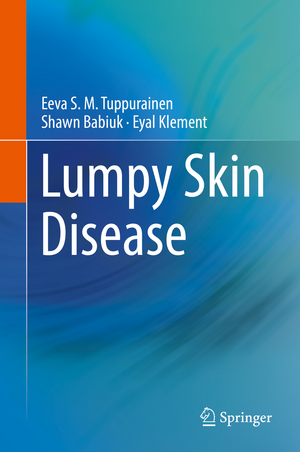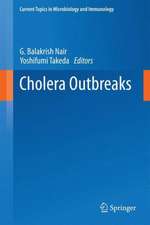Lumpy Skin Disease
Autor Eeva S. M. Tuppurainen, Shawn Babiuk, Eyal Klementen Limba Engleză Hardback – 25 iul 2018
This book provides a comprehensive but concise overview on the economically important emerging cattle pox virus derived Lumpy Skin Disease, including the characteristics of causative agent, description of clinical signs in cattle, pathology and histopathology, immunity, geographical distribution, epidemiology and transmission pathways, control and eradication of the disease. In addition the recent developments in vaccination, mathematical modeling and risk assessment are discussed. Lumpy Skin Disease currently spreads aggressively across the Middle and Near East. The first incursion to the European Union territory occurred in Greece in autumn 2015.
The book targets clinicians and field veterinarians in Lumpy Skin Disease affected regions, veterinary authorities as well as advanced students in veterinary medicine and virology.
| Toate formatele și edițiile | Preț | Express |
|---|---|---|
| Paperback (1) | 324.06 lei 38-44 zile | |
| Springer International Publishing – 25 ian 2019 | 324.06 lei 38-44 zile | |
| Hardback (1) | 367.07 lei 3-5 săpt. | |
| Springer International Publishing – 25 iul 2018 | 367.07 lei 3-5 săpt. |
Preț: 367.07 lei
Preț vechi: 386.39 lei
-5% Nou
Puncte Express: 551
Preț estimativ în valută:
70.24€ • 73.60$ • 58.06£
70.24€ • 73.60$ • 58.06£
Carte disponibilă
Livrare economică 22 martie-05 aprilie
Preluare comenzi: 021 569.72.76
Specificații
ISBN-13: 9783319924106
ISBN-10: 3319924109
Pagini: 115
Ilustrații: VI, 109 p. 10 illus., 7 illus. in color.
Dimensiuni: 155 x 235 mm
Greutate: 0.38 kg
Ediția:1st ed. 2018
Editura: Springer International Publishing
Colecția Springer
Locul publicării:Cham, Switzerland
ISBN-10: 3319924109
Pagini: 115
Ilustrații: VI, 109 p. 10 illus., 7 illus. in color.
Dimensiuni: 155 x 235 mm
Greutate: 0.38 kg
Ediția:1st ed. 2018
Editura: Springer International Publishing
Colecția Springer
Locul publicării:Cham, Switzerland
Cuprins
Chapter 1: Introduction to lumpy skin disease.- Chapter 2: General description of lumpy skin disease.- Chapter 3: Economic impact of lumpy skin disease.- Chapter 4: Geographic distribution of lumpy skin disease.- Chapter 5: Current legislation and trade recommendations. Part I: Lumpy skin disease virus: Chapter 6: Taxonomy.- Chapter 7: Morphology.- Chapter 8: Genome.- Chapter 9: Replication in a host.- Chapter 10: Propagation of the virus in vitro.- Chapter 11: Persistence and stability of the virus.- Chapter 12: Immunity.- Chapter 13: Epidemiology and transmission. Part II: Early detection of lumpy skin disease, diagnostic tools and treatment. Chapter 14: Clinical signs.- Chapter 15: Sample collection and transport.- Chapter 16: Diagnostic tools.- Chapter 17: Treatment of lumpy skin disease. Part III: Control and eradication. Chapter 18: Vaccines against lumpy skin disease and vaccination strategies.- Chapter 19: Slaughter of infected and in-contact animals.- Chapter 20:Animal movement control and quarantine.- Chapter 21: Vector surveillance and control.- Chapter 22: Decontamination and disinfection.- Chapter 23: Active and passive surveillance.
Notă biografică
Dr. Eeva Tuppurainen is an independent veterinary expert for lumpy skin disease (LSD), sheeppox (SPP) and goatpox (GTP). For more than a decade, she headed a UK based the World Organization for Animal Health (OIE) reference laboratory for LSD, SPP and GTP. Her responsibilities included provision of diagnostic services, technical assistance and training on capripoxviruses (CaPV) for the OIE Member States. In this role, she was responsible for implementing various research projects on the CaPV field.
During the recent LSD outbreaks in Europe and the northern Caucasus, she has served as a team leader for several European Union (EU) Community Veterinary Emergency Team (CVET) missions, followed by a series of sustained technical assistance missions to the LSD affected and at-risk Balkan countries under the framework of the EU Better Training Safer Food-initiative. In early 2017 she contributed as a short term external consultant for FAO LSD projects, providing disease expertise in designing effective disease control and eradication measures, preparing training courses, awareness material, LSD Field Manual and a contingency plan template. Currently, she is engaged as a Senior Animal Health Expert, in an EU funded project in the northern part of Cyprus.
Dr. Shawn Babiuk received a Bachelor of Science in Biochemistry from the University of Saskatchewan in 1997 and a Doctorate in Pharmaceutical Sciences from the University of Saskatchewan in 2003. He completed postdoctoral training in Saskatoon on genomics with Pyxis Genomics Canada and on vaccine development at Vaccine & Infectious Disease Organization, University of Saskatchewan. In 2005, he moved to the National Centre for Foreign Animal Disease in Winnipeg as a research scientist for the Canadian Food Inspection Agency. In 2006, he became an Adjunct Assistant Professor in the Department of Immunology at the University of Manitoba. Dr. Babiuk’s research is focused on foreign animal disease. His research interests consist of understanding the pathogenesis as well as developing diagnostics and vaccines for several foreign animal diseases such as capripox, peste des petits ruminants, African swine fever as well as newly emerging zoonotic diseases such as influenza and Rift Valley fever.
Dr. Eyal Klement is an associate professor of veterinary epidemiology in the Koret School of Veterinary Medicine in the Hebrew Universtiy. He graduated DVM studies in the Hebrew University and completed a Master degree in epidemiology at the Tel-Aviv University in Israel. His main research interest is aimed at the epidemiology of infectious diseases in animals and humans and vaccine evaluation. He is the head founder of the Veterinary Master of Public Health program at the Hebrew University. Eyal is a consultant of EFSA and the EUFMD on several topics such as the risk of vector-borne disease introduction to Europe, Lumpy skin disease and evaluation of FMD vaccine effectiveness. He is also an associate editor of Frontiers in Veterinary Science, section Veterinary Epidemiology, and Economics.
During the recent LSD outbreaks in Europe and the northern Caucasus, she has served as a team leader for several European Union (EU) Community Veterinary Emergency Team (CVET) missions, followed by a series of sustained technical assistance missions to the LSD affected and at-risk Balkan countries under the framework of the EU Better Training Safer Food-initiative. In early 2017 she contributed as a short term external consultant for FAO LSD projects, providing disease expertise in designing effective disease control and eradication measures, preparing training courses, awareness material, LSD Field Manual and a contingency plan template. Currently, she is engaged as a Senior Animal Health Expert, in an EU funded project in the northern part of Cyprus.
Dr. Shawn Babiuk received a Bachelor of Science in Biochemistry from the University of Saskatchewan in 1997 and a Doctorate in Pharmaceutical Sciences from the University of Saskatchewan in 2003. He completed postdoctoral training in Saskatoon on genomics with Pyxis Genomics Canada and on vaccine development at Vaccine & Infectious Disease Organization, University of Saskatchewan. In 2005, he moved to the National Centre for Foreign Animal Disease in Winnipeg as a research scientist for the Canadian Food Inspection Agency. In 2006, he became an Adjunct Assistant Professor in the Department of Immunology at the University of Manitoba. Dr. Babiuk’s research is focused on foreign animal disease. His research interests consist of understanding the pathogenesis as well as developing diagnostics and vaccines for several foreign animal diseases such as capripox, peste des petits ruminants, African swine fever as well as newly emerging zoonotic diseases such as influenza and Rift Valley fever.
Dr. Eyal Klement is an associate professor of veterinary epidemiology in the Koret School of Veterinary Medicine in the Hebrew Universtiy. He graduated DVM studies in the Hebrew University and completed a Master degree in epidemiology at the Tel-Aviv University in Israel. His main research interest is aimed at the epidemiology of infectious diseases in animals and humans and vaccine evaluation. He is the head founder of the Veterinary Master of Public Health program at the Hebrew University. Eyal is a consultant of EFSA and the EUFMD on several topics such as the risk of vector-borne disease introduction to Europe, Lumpy skin disease and evaluation of FMD vaccine effectiveness. He is also an associate editor of Frontiers in Veterinary Science, section Veterinary Epidemiology, and Economics.
Textul de pe ultima copertă
This book provides a comprehensive but concise overview on the economically important emerging cattle pox virus derived Lumpy Skin Disease, including the characteristics of causative agent, description of clinical signs in cattle, pathology and histopathology, immunity, geographical distribution, epidemiology and transmission pathways, control and eradication of the disease. In addition the recent developments in vaccination, mathematical modeling and risk assessment are discussed. Lumpy Skin Disease currently spreads aggressively across the Middle and Near East. The first incursion to the European Union territory occurred in Greece in autumn 2015.
The book targets clinicians and field veterinarians in Lumpy Skin Disease affected regions, veterinary authorities as well as advanced students in veterinary medicine and virology.
Caracteristici
First book entirely dedicated to Lumpy Skin Disease Provides in-depth insights into epidemiology and geographic distribution of cattle pox virus Essential guide for researchers, students and field veterinarians in LSD affected regions


























